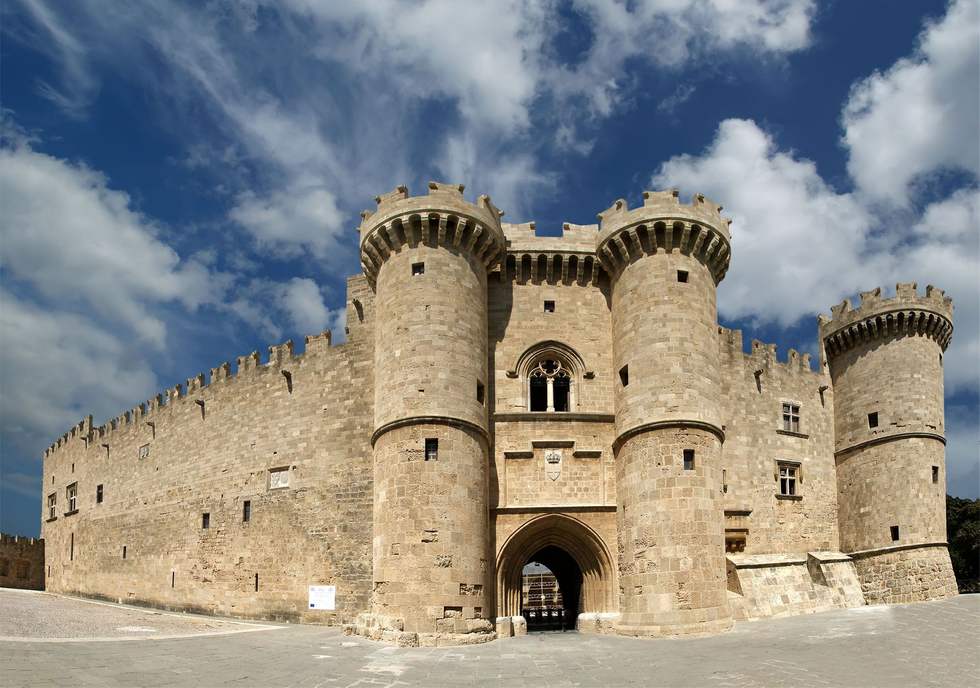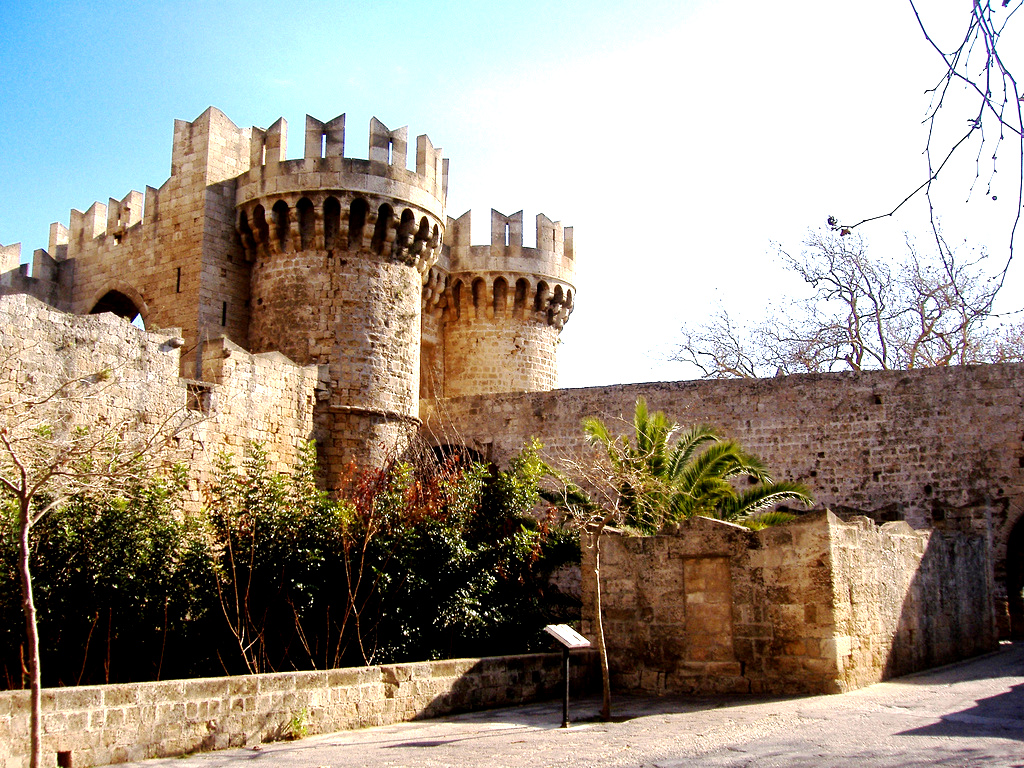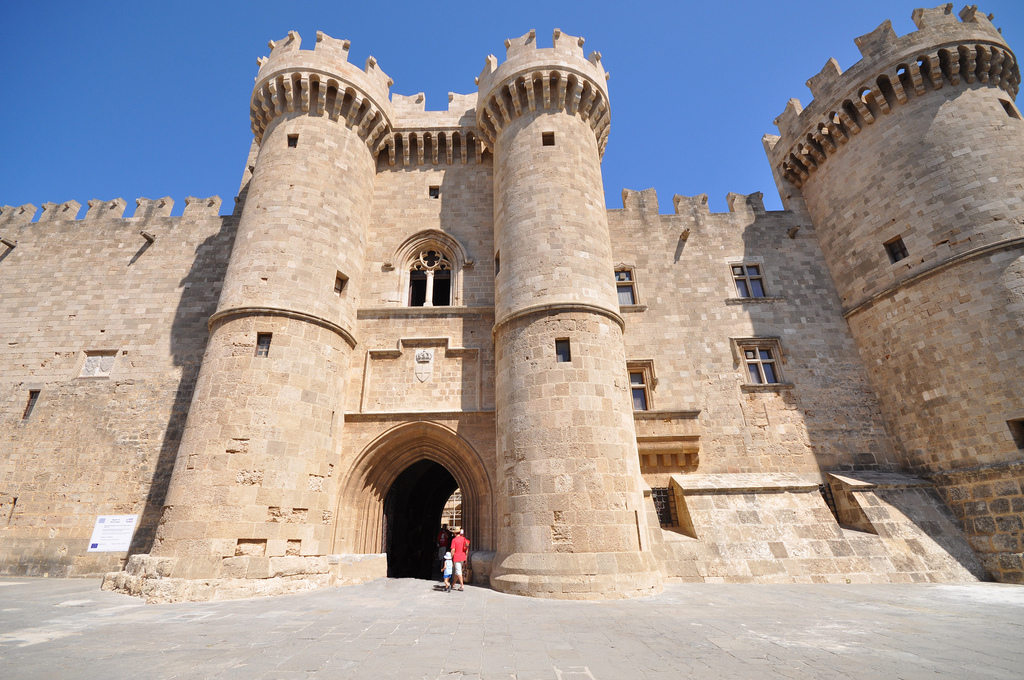The fortifications of the town of Rhodes are shaped like a defensive crescent around the medieval town and consist mostly in a modern fortification composed of a huge wall made of an embankment encased in stone, equipped with scarp, bastions, moat, counterscarp and glacis. The portion of fortifications facing the harbour is instead composed of a crenellated wall. On the moles towers and defensive forts are found.
They were built by the Knights Hospitaller of Saint John by enhancing the existing Byzantine walls starting from 1309, the year in which they took possession of the island after a three-year struggle.
Like most of the defensive walls they were built with a technique called rubble masonry which allows for a great mass capable of withstanding the gunshots with smooth external stone faces to avoid climbing.
The defence of different portions of fortifications was assigned to different Langue (tongues) of Knights. The North face was under the rule of the Grand Master, then moving West and South the posts were hold by the Langue of France and Alvernia, the Langue of Spain (Spanish and Portuguese), the Langue of Germany (English and German), and the Langue of Italy. Bastions and terrepleins still hold the name of the langue involved (e.g. Bastion of Italy, terreplein of Spain).
Due to its geographical position as a gate to the Aegean Sea, Rhodes has always had a vantage position on the trade routes between the West and the East and has been an important stop thanks to its well protected harbours. During the Hellenistic period in the late 4th century BC, the town of Rhodes was already enclosed in defensive walls which allowed to withstand the siege of Demetrius Poliorketes king of Macedonia, in 305 BC. The famous Colossus of Rhodes was built to thank gods for the victory against Demetrius.
Philo of Byzantium author of the treatise "Paraskeuastica" on defensive works, stayed in Rhodes in the 3rd century BC and expressed his admiration for its walls.The Rhodes earthquake of 226 BC severely damaged the fortifications, but they were soon rebuilt. The Byzantines built a fortress on the highest part of the town.
When the Knight Hospitallers arrived, the town was still wealthy but in decline. Rhodes underwent an economical growth thanks to the richness that the knights brought in from the Holy Land and to the inheritance of the Templar's assets given to the Hospitallers after the Templar Order was suppressed in 1312 by decree of the king of France Philip IV. The richness of the island attracted the Ottomans from the nearby coast (Turkey is just 18 km away and can be easily seen from Rhodes). The knights started continuous works on the fortifications, both to include the new villages in the South of the historical Byzantine town and to update the fortification to the new military defensive techniques after the artillery started to be used currently as a siege means.
The Knights of Saint John had had a long experience in building fortresses and fortifications during the almost three centuries of their stay in the Holy Land, nevertheless the reference model for the construction of the fortification were the Theodosian Walls of Constantinople which, during the centuries, had shown a great capacity to withstand sieges.
The expansion of the walls was undertaken by Grand Master Antonio Fluvian de Riviere who allowed the (medieval) town of Rhodes to reach the current area of about 42 hectares (104 acres). The wall curtain was finished between 1457 and 1465. The Byzantine fortifications were demolished leaving just a portion of those of the old fort known at the time of Knights as Collachium (Greek: Κολλάκιον).
In 1440 the Mameluke sultan of Egypt tried without success to conquer the town sieging it for 40 days.
In 1480 Rhodes was besieged by the troops of Mehmed II but the powerful army of the conqueror of Constantinople manned with 100,000 troops and 170 ships was repelled by the courage of the Knights and the strong fortifications, notwithstanding the outnumbering assailants. In 1481 a destructive earthquake struck the island causing severe damages to the houses and the fortification and about 30,000 casualties. A new Ottoman siege could not be withstood, so the Knights made available their great financial resources and in a very short time the most important palaces of the town and the fortifications were rebuilt. In the following years Grand Masters Pierre d'Aubusson, Emery d'Amboise, Fabrizio del Carretto and Philippe Villiers de l’Isle Adam ordered the fortifications to be rebuilt to withstand the cannons. For the purpose they called to Rhodes the best Italian military architects. Among them Matteo Gioeni, Basilio della Scuola, Gerolamo Bartolucci and Gabriele Tadino da Martinengo. The latter two were present in Rhodes during the final siege in 1522.
The Bastion of Italy (or Post of Italy) in which the Ottomans had opened a breach in 1480 was rebuilt with a powerful chemin de ronde for the reverse fire of cannons on the nearby spans of wall. This bastion was named "Bastion Del Carretto" after the Grand Master. The gate of Saint John was closed and a pentagonal bastion with the same name was built on the western side of the walls to guard Gate d'Amboise. After The Ottoman conquered Rhodes in 1522 they did not demolish the walls but repaired them and kept them under maintenance during the four centuries of their rule.
The fortifications of Rhodes were frozen at 1522 so that Rhodes is one of the few European walled towns that still shows the transition between the classical medieval fortification and the modern ones. The fortifications that still today make a belt around the medieval town, so that it is a separate neighbour from the new town, were restored during the Italian administration of the island and are, at present (2011), being studied, restored and maintained.
After their expulsion from Rhodes, the Hospitallers moved to the central Mediterranean island of Malta in 1530. They settled in the town of Birgu, and the first fortifications they built within the city were in a similar style to the fortifications of Rhodes.












